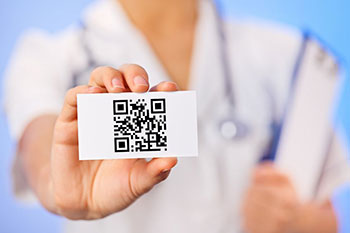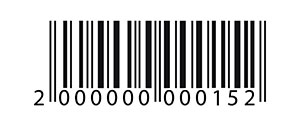Barcoding – Bars and Boxes: From Linear to Matrix Barcoding
By Tom Inglesby
 |
|
| A matrix code or 2D barcode |
Barcodes are everywhere. In the hospital environment, they are used for tracking medication, IV fluids, equipment and, of course, patients themselves. What are these ubiquitous lines and squares? Where did they come from, and, most important, what can we do with them?
The history of the barcode starts at Westinghouse in 1930 with an invention by John Kermode, Douglas Young, and Harry Sparkes. It was envisioned as a way to automate the payment of utility bills with printed bars (called code marks) on the bill, which was read by a recently invented photo-cell circuit. By 1933, all the basic concepts of barcoding in use today were in place: dark bars printed on paper, light shining on the bars, and a circuit determining the relative position of the bars. Different ways to arrange the bars—the barcode symbology—were envisioned, but the technology wasn’t really in place to make barcodes practical in general use until much later.
The first barcode-scanned sales transaction occurred on June 26, 1974. The National Association of Food Chains had adopted the UPC (Universal Product Code) the prior year. On that June morning, a 10-pack of Wrigley’s Juicy Fruit Gum was officially the first item scanned and sold with a barcode. It is displayed in the Smithsonian today.
In the 1990s, matrix codes, also known as 2D barcodes, arrived. Matrix barcodes, such as the popular QR code, are capable of encoding thousands of characters in their blips and boxes, opening up a whole new level of barcode functionality. According to RAD DeRose, CEO of barcode scanner company L-Tron Corp. in Victor, New York, “Instead of scanning a barcode and having to rely on database connectivity, the increased capacity [of the 2D barcode] allowed for encoding enough data to tell a story in a single barcode.”
Robert Chadwick, president of EndurID in Hampton, New Hampshire, explains, “There is a big shift to 2D barcodes. The 1D, or linear barcode, seems to be falling out of favor because it’s just hard to scan. With linear barcodes, there could be a problem with long medical record numbers because the curvature around the wrist would make it very hard for the readers to read the whole thing. The 2D barcodes are very easy to read because you don’t have the problem with curvature.”
The high density of the matrix code, while providing significantly increased data storage, also increases the demands on the printer and media. “We print directly on the bands with a color laser printer,” says Chadwick. “We can put 2D, high density barcodes directly on a wristband, and we can reduce them to as small as an eighth-inch square, and they are still readable. We can definitely get the resolution, and they’re very, very reliable. Distortion is not a problem and, since they’re smaller, you can put multiple barcodes on a band; you have built-in redundancy.”
Why a color laser and not just the much more common mono-color laser printer? “We use a lot of color on our wristbands,” Chadwick says. “One of our largest accounts, the VA hospitals, uses color coding throughout their system. They color code for the standard set: allergy, fall, DNR, and now we’re seeing color coding for wanderers, swallow precautions, and sleep apnea.”
 |
|
| Linear or 1D barcode |
Is there a standard color coding chart now being used? “The hospital associations in each state have settled on standards. Allergies are always red. Falls are always yellow. DNR is always purple. And then they have restricted extremity, which is pink, and latex allergy, which is green. After that, the hospitals do what they want as far as color.”
He continues, “We start with white bands, and, using the color laser printer, we can make them any color you like. That allows us to personalize the band for an individual allergy, for example.” Secondary color wristbands are common but they have no individual data on them. If they come off the patient and you find them on the floor, you have no idea who it belongs to. “The way we do it, by putting color on the primary band, if you find the band, you’ve found everything; you’ve found their identification, you’ve found the fact that they were a fall risk and it fell off, you know that patient needs to be re-banded. I think there’s a little more safety there. There’s also an audit trail, so we try to build a lot of that in.”
Taking another approach is PDC Healthcare in Valencia, California. PDC Healthcare developed the first barcode wristband system in 1984. Their bands meet the requirements of The Joint Commission and the World Healthcare Organization for improving the accuracy of patient identification, HIPAA for protection of patient privacy, and AHA to reduce risk of lost or transferred data.
PDC also uses both 1D and 2D codes on their wristbands but to assure accurate reading, they have developed a relationship with Brother, the well-known printer company, to co-brand an advanced printing system called TrustSense.
David Crist, vice president at Brother, discussed the new printer developed with PDC wristbands in mind. “It’s direct thermal technology and a brand new platform for Brother. It uses two-inch wide material and is focused on the wristband and label area. The unique feature about the solution is that we’ve got a tightly linked technology setup between PDC consumables and the Brother printer—recognizing the correct consumable and having that match up with other clinical information. We focused on a printer platform that was portable—it’s battery-powered and wireless enabled—that is very easy to use, with a high degree of compatibility, and that can be used with a nice assortment of market-leading consumables from PDC. That was the development philosophy that drove us to where we are now.”
PDC and Brother worked together to be sure the material and the printer worked together. “There is a patented pattern recognition technology that’s applied to the back of the media itself,” explains Crist, “and that is recognized by sensors and firmware within the printer to provide drop-in calibration and error detection capability.”
Being a battery-powered portable, there is a concern for battery life. According to Duane Yamashita, product manager for the printer, “The battery life is guaranteed to a minimum of one full, five-inch diameter roll. So that can be 200 wristbands or 1,000 labels. It really depends on the usage. It’s a long-life lithium ion battery that charges rather quickly.”
One feature that makes life a little easier for clinicians is that the printer doesn’t require complex threading or spooling of the material. “It’s drop in and move on to the next task at hand,” claims Crist. “You don’t have to do a lot of programming or setup manipulation. That was a cool development that our engineers came up with—there is no spindle involved, so we just drop in the media. It’s got a couple of sensors that keep things aligned, and off you go.”
Clinicians want something easy to use that doesn’t require a call to the IT department to fix a problem. Yamashita notes, “In the world of blinking lights and not really understanding error messages, we needed to provide a way that was clear on how to correct errors. That is also the first potential patient safety concern, where you could end up putting an adult barcode and adult information on a baby. That could be disastrous in terms of misidentification of the patient. There’s two-way feedback between the hospital information system and the printer itself, which can send alerts back to a centralized console. A quality manager in the hospital could be an extra layer of protection and control to prevent misidentification at the point of printing.”
Whether portable thermal printing on special media or color laser printing on durable blank media, the barcoded wristband is here to stay. The trend to matrix (2D) high-density coding will advance the accuracy and therefore the safety of the information embedded in the wristband, adding another layer to the safety for the patient.
Tom Inglesby is an author based in southern California who writes frequently about medical technologies and improvement strategies.
